おすすめの Google 拡張機能です!新しい言葉を勉強しましょう!
Here are the recommended Chrome extensions! Let’s learn new words here!
ポッドキャストプラットフォーム|Platforms of Podcast
こちらの記事は、配信中のポッドキャストのスクリプトです。
ぜひ、ポッドキャストを聞きながら読んでください。
 えみ先生
えみ先生もう聞いた人は、クイズをチェックしましょう!
ちょっとクイズ!|CHOTTO Quiz!
ポッドキャストを聞いた人は、ちょっとクイズを解いてみましょう。
むずかしいときは、下のスクリプトを読んで、もう一度クイズをチェックしてみてください。
【えいご】English Translation
Answer these quiz questions if you’ve listened to a new episode of my podcast.
If it was difficult, read the transcript below and try again.
❓ 日本語の文字は 何種類ありますか?|How many types of characters are there in Japanese?
3種類あります。ひらがなと カタカナと 漢字です。✍️
There are 3 main types: Hiragana, Katakana, and Kanji.
❓ 日本語の動詞には、いくつ フォーム(形)がありますか?|How many verb forms are there in Japanese?
動詞だけで 11のフォームがあります。
There are 11 different forms for each verb.
❓ 文を作るとき、日本語では 何が一番最後ですか?|In Japanese, what comes at the end of a sentence?
日本語では、「動詞」を文の最後に 言います。日本語の順番: 時間→場所→方法→人→動詞
The verb comes at the end. Japanese word order: Time >> Place >> Method >> Person >> Verb
ポッドキャストのスクリプト|Transcript of Podcast
エピソード25、「日本語の勉強でむずかしいこと」
このポッドキャストは、初中級(Pre-Intermediate)レベルです。
おはようございます。こんにちは。こんばんは。
日本語の先生、エミです。
最近、本当に むし暑いですね。
じめじめしています。
みなさんの住んでいるところはどうですか?
週末、東京で友達と昼ご飯を食べに行ったんですけど、もう…暑すぎました。
暑すぎて、歩いているとき ずっと汗をかいていました。
これからもっと暑くなるので、みなさんも水をたくさん飲んでくださいね。
【えいご】English Translation
Good morning. Hello. Good afternoon.
I am a Japanese teacher, Emi.
It’s been really humid lately.
It feels sticky and damp.
How is the weather where you live?
Over the weekend, I went to eat lunch with a friend in Tokyo, and it was way too hot.
I was sweating the entire time I was walking.
Since it’s going to get even hotter from now on, please make sure to drink plenty of water.
水を飲まないと、「熱中症」になってしまいます。
熱中症は、体が熱くなって 体調が悪くなることです。
病気の名前ですね。
英語で、Heat Strokeです。
私も気をつけて、水をたくさん飲むようにします。
みなさんも気をつけてくださいね。
【えいご】English Translation
If you don’t drink water, you might get Necchusyo.
Necchusyo is when your body overheats and you feel unwell.
It’s a type of illness.
In English, it’s called “heat stroke.”
I’ll be careful and drink lots of water too.
Please take care of yourselves.
ここで先週の質問をチェックしましょう。
先週は こんな質問をしました。
「日本語の勉強で、今 何をがんばっていますか?
どうやって勉強していますか?」
こんな質問でした。
【えいご】English Translation
Alright, now let’s check last week’s question.
Last week, I asked this question:
“What are you working hard on in your Japanese studies?
How do you study?”
That was the question.
みなさんは、いつから日本語を勉強していますか?
日本語の勉強はどうですか?
楽しいですか?
かんたんですか?
それとも、むずかしいですか?
語学…、語学は、日本語とか、英語とかスペイン語とか、みなさんが話している言葉です。
Languageです。
語学の勉強は、たくさん覚えることがありますよね。
むずかしいと思います。
私も、学生の時から 英語を勉強していますけど、今でも むずかしいです。
【えいご】English Translation
When did you all start studying Japanese?
How’s it going?
Is it fun? Easy? Or difficult?
Gogaku—like Japanese, English, or Spanish, the language you speak—is something that involves a lot of memorization.
I think it’s hard.
I’ve been studying English since I was a student, and even now I still find it difficult.
今日は、日本語を勉強している人が日本語でむずかしいと思っていることを シェアします。
そして、私のアドバイスも話したいと思います。
私の生徒が、日本語でむずかしいことを教えてくれました。
今日は、特に むずかしいことを3つ話します。
【えいご】English Translation
Today, I want to share what some people studying Japanese find difficult,
and also give some advice.
Some of my students told me what they find hard about Japanese.
Today, I’ll talk about three particularly difficult things.
1つ目は、「日本語の文字が むずかしい」です。
日本語は3種類の文字があります。
ひらがな、カタカナ、漢字です。
あと、ローマ字もあります。
ローマ字はアルファベットを使って言葉を作ります。
でも、日本語を話すとき、あまりローマ字は使いません。
ひらがな、カタカナ、漢字を使います。
【えいご】English Translation
The first one is that Japanese characters are difficult.
Japanese uses three types of writing: hiragana, katakana, and kanji.
There’s also romaji, which is using the alphabet to write Japanese words.
But when speaking Japanese, we don’t use romaji very much.
We mainly use hiragana, katakana, and kanji.
ひらがなは、まあ、みんながんばって覚えますね。
たくさん書いて練習しています。
でも、カタカナと漢字が難しいみたいです。
私のアドバイスは、少しずつ練習することです。
少しずつです。
ひらがなは46文字、カタカナも46文字あります。
この2つで92文字です。
92。多いですね。
【えいご】English Translation
Hiragana—well, most learners try hard to remember them.
They practice writing them a lot.
But katakana and kanji seem to be harder.
My advice is to practice little by little.
Step by step.
Hiragana has 46 characters. Katakana also has 46 characters.
That makes 92 characters in total.
92… That’s a lot.
そして、漢字はもっとたくさんあります。
本や新聞を読むためには、2136文字の漢字が読めなければいけません。
2136文字、2136です。
たくさんあります。
大変ですよね。
でも、私も漢字があまり得意じゃないです。
ほとんどの漢字が読めますけど、書けない漢字もあります。
だから私も勉強しています。
【えいご】English Translation
And there are even more kanji.
To read books and newspapers, you need to know 2,136 kanji.
2,136 characters—that’s a huge number.
It’s tough.
But I’m also not very good at kanji.
I can read most of them, but there are some I can’t write.
So I’m still studying, too.
文字を覚えるアドバイスは、「くりかえし」です。
くりかえしはRepeatという意味です。
見て、書いて、読んで、言う。
これを、くりかえししましょう。
見て、書いて、読んで、言う。
Look, write, read and say it out loudですね。
【えいご】English Translation
My advice for remembering characters is “Kurikaeshi“.
Kurikaeshi means repeat (repetition) in Japanese.
Look, write, read, and say it out loud.
Keep doing that over and over.
これを少しずつ、毎日 5つずつ練習してみてください。
ゆっくりですけど、日本語の文字を覚えることができます。
みなさんは文字を覚えるとき、どうやって練習しましたか?
ぜひ教えてください。
【えいご】English Translation
Try practicing five characters a day.
Slowly but steadily, you’ll be able to remember Japanese characters.
How did you practice when you were learning the characters?
Please share!
そして、2つ目の日本語で難しいことは、「動詞の活用」です。
動詞は、行きます、食べます、飲みます、勉強します…、アクションの言葉です。
そして活用は、辞書形、て形、ない形…、Conjugationです。
いろんなフォームがありますよね。
動詞は11のフォームがあります。
おぼえるのはとっても大変ですね。
だから、動詞のチートシートを作りました。
【えいご】English Translation
The second difficult part of Japanese is verb conjugation.
Doushi (Verbs) like “go,” “eat,” “drink,” and “study”—they’re action words.
And Katsuyou (conjugation) refers to different forms like dictionary form, te-form, nai-form, etc.
There are a lot of forms, right?
Japanese verbs have 11 forms.
It’s very hard to memorize them all.
That’s why I made a cheat sheet for verb forms.
私とレッスンをしている生徒に、無料で…、Freeでプレゼントしています。
レッスンをしていない人も、BuymeaCoffeeのサイトで買うことができます。
よかったら、リンクをチェックしてみてくださいね。
動詞は、ルールと練習が大切です。
チートシートを見ながら練習してみてください。
【えいご】English Translation
I give it for free to students who take lessons with me.
If you’re not one of my students, you can also buy it from my Buy Me a Coffee page.
Please check the link if you’re interested.
When learning verbs, rules and practice are important.
Try practicing while looking at the cheat sheet.

最後の3つ目の むずかしいことは、「長い文を作るのがむずかしい」です。
長い文は むずかしいですね。わかります。
私も英語で長い文を作りたいとき、ときどきフリーズします。
止まります。
そして、考えて、すこしずつ長い文を作ります。
【えいご】English Translation
The third difficult thing is making long sentences.
Long sentences are difficult, I understand.
Even I sometimes freeze when I want to make a long sentence in English.
I stop,
think, and slowly build the sentence bit by bit.
もちろん みじかい文でも大丈夫です。
でも、説明したいとき、文が長くなりますね。
時間、場所、人、たくさん言葉があるとき、どれが1番ですか?どれが2番ですか?
むずかしいと思います。
言葉の順番…、順番はOrderです。
言葉の順番を いっしょにチェックしましょう。
【えいご】English Translation
Of course, short sentences are fine.
But when you want to explain something, sentences tend to get longer.
When you have many elements like time, place, people—it’s hard to know which comes first, which is second, and so on.
I think it’s difficult.
Junban… which means “Order.”
Let’s check the word order together.
たとえば、この文を聞いてください。
「週末、ディズニーランドに 電車で 友だちと 行きました。」
この文、意味はわかりますか?
たくさん言葉を使いました。
順番、Orderをチェックしましょう。
【えいご】English Translation
For example, listen to this sentence:
“On the weekend, I went to Disneyland by train with a friend.”
Do you understand the meaning?
There are a lot of parts in that sentence.
Let’s check the Junban (order):
1番、週末、Weekend、これは「時間」です。
時間は最初に言います。
2番、ディズニーランド、これは「場所」です。
2番目に言います。
3番、電車で、by train、これは「方法」です。
方法はMethodですね。
どうやってディズニーランドに行きましたか?>>>電車です。
4番、友だちと、これは「人」です。
誰と行きましたか?>>>友だちと行きました。
そして5番、行きました、これは「動詞」アクションの言葉です。
日本語では、動詞を最後に言います。
【えいご】English Translation
First, “on the weekend”—this is the time.
Time comes first.
Second, “to Disneyland”—this is the place.
Place comes second.
Third, “by train”—this is the Houhou (method).
How did I go to Disneyland? >>> By train.
Fourth, “with a friend”—this is the person.
Who did I go with? >>> With a friend.
And finally, the verb comes last in Japanese—“I went.”
We say a verb at the end.
3番の「方法」…、Methodと4番の「人」Person, peopleは逆でもいいです。
たとえば、
「週末、ディズニーランドに 友だちと 電車で 行きました。」
これもオッケーです。
【えいご】English Translation
The third and fourth—method and person—can be switched.
For example,
“On the weekend, I went to Disneyland with a friend by train.”
That’s okay, too.
うん、この文のほうがいいです。
電車という言葉は、あまり大事じゃないです。
でも、友だちは大事ですね。
みなさん、質問するとき「どうやっていきましたか?」と聞きたいですか?
あんまり興味がないですよね。
たぶん、「誰と行きましたか?」と聞きたいと思います。
だから、友だちを電車より先に言います。
【えいご】English Translation
Actually, I think this sentence is better.
“Train” isn’t such an important word.
But “friend” is.
When asking questions, you probably don’t want to ask “How did you get there?”
That’s not so interesting.
You probably want to ask, “Who did you go with?”
So it makes sense to mention the friend before the train.
順番を覚えると、文を作るのが 少し かんたんになると思います。
もう1度チェックしましょう。
文の順番、Order は
時間▶︎場所▶︎方法▶︎人▶︎動詞 です。
【えいご】English Translation
If you remember this word order, it might get a little easier to make sentences.
Let’s check it again:
Time ▶︎ Place ▶︎ Method ▶︎ Person ▶︎ Verb.
最初は、みじかい文から始めましょう。
「今日は、パンを食べました。」
みじかい文です。でもいいですね。
これから長い文を作ります。
「今朝、コンビニで パンを 一人で 食べました。」
すこしずつ長くしてみてください。
【えいご】English Translation
Start with short sentences:
“Today, I ate bread.”
It’s short, but that’s fine.
Then try making longer sentences:
“This morning, I ate bread alone at the convenience store.”
Try making your sentences a little longer, step by step.
日本語の勉強は、ときどき楽しいですけど、ときどき大変ですよね。
でも大丈夫です。
みなさん、すこしずつ上手になっています。
むずかしいことは、1つずつ勉強しましょう。
がんばっている みなさんを応援しています。
一緒に がんばりましょう。
【えいご】English Translation
Studying Japanese is sometimes fun, and sometimes difficult.
But it’s okay.
Everyone is getting better, little by little.
Let’s study one difficult thing at a time.
I’m cheering for all of you who are working hard.
Let’s do our best together!
では、今日も みなさんに 質問があります。
「みなさんは、どうやってモチベーションを上げていますか?」
たとえば、日本語の勉強、むずかしいですよね。
日本語じゃなくても、学校の勉強や ほかの語学の勉強、仕事、むずかしいことはたくさんあります。
そんな時、どうやってモチベーションを上げていますか?
ぜひ教えてください。
【えいご】English Translation
Now, I have a question for you today, as always.
“How do you stay motivated?”
For example, studying Japanese is difficult.
Even if it’s not Japanese—schoolwork, other languages, work—there are many difficult things.
In those times, how do you keep your motivation up?
Please let me know!
今日のポッドキャストのスクリプトは、私のウェブサイトにあります。
ウェブサイトは、 en-nihongo.com です。
よかったら、ポッドキャストの感想や、質問の答えをコメントで教えてください!
じゃあ、また来週のポッドキャストで会いましょう。
じゃあね~!
【えいご】English Translation
A transcript for today’s podcast is on my website.
The website is en-nihongo.com .
I’d be very happy if you could share your thoughts/impressions or could answer the question I asked in this episode!
I’ll see you in the next episode.
Jaa ne-!
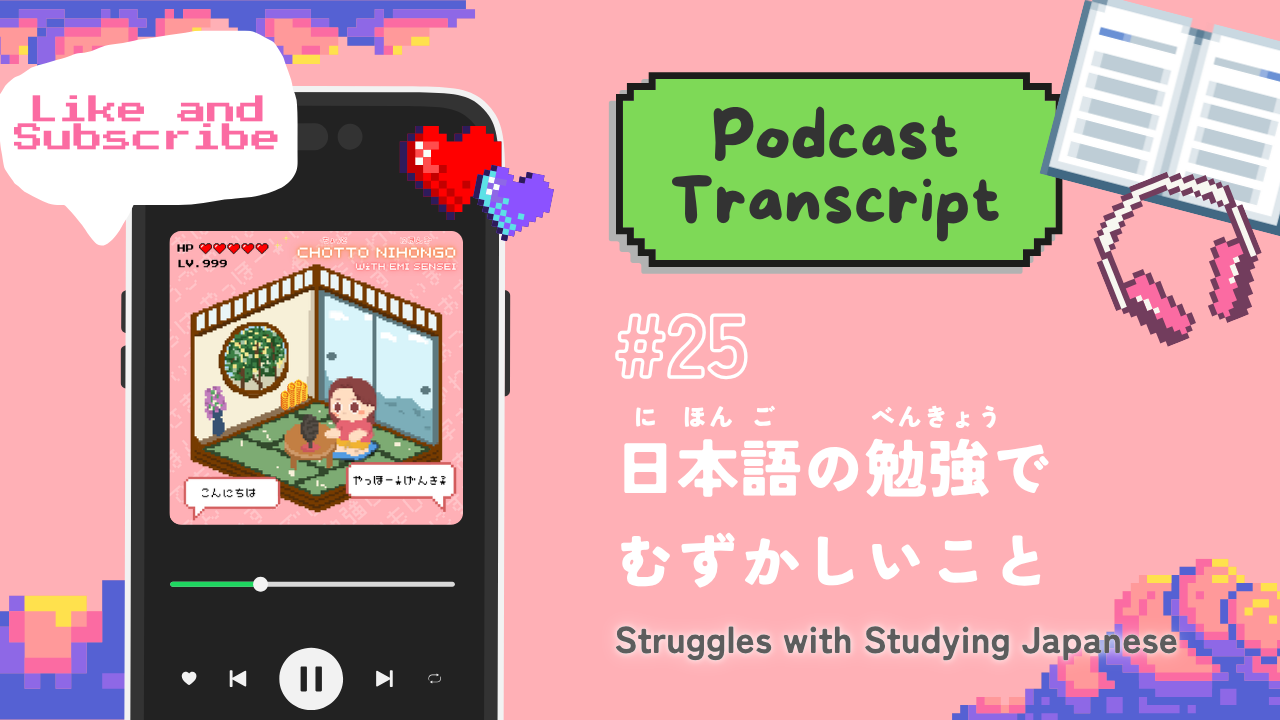
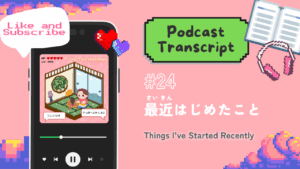
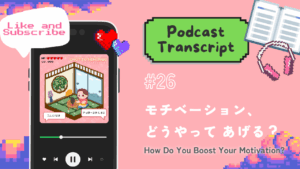
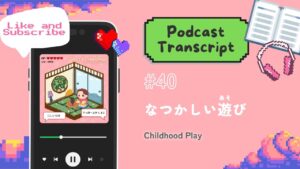
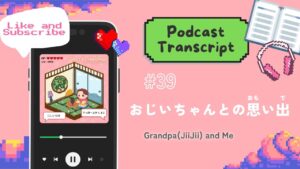
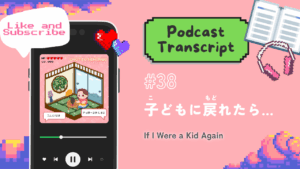
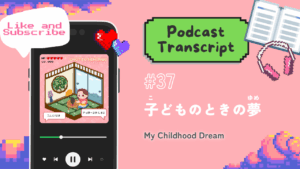
コメント|Comment